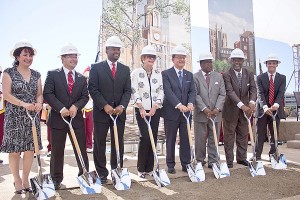University officially breaks ground on new Village
USC President C. L. Max Nikias was joined by several Los Angeles elected officials on Monday for the groundbreaking of the new Village at USC, one of the largest economic development projects in South Los Angeles history.

It takes a village · USC President C.L. Max Nikias was joined by Los Angeles elected officials and Undergraduate Student Government President Andrew Menard for the groundbreaking ceremony of The Village. – Joseph Chen | Daily Trojan
Set to open in the fall of 2017, the project will prominently feature residential, retail and recreational facilities. With over 1.25 million square feet of space, the $650 million Village will be designed to resemble a medieval Tuscan plaza. The project will be built around the idea of a European town square that will include a central promenade with coffee shops, restaurants and residential colleges.
“This is a historic day for the university but also for the city of Los Angeles,” Nikias said in his opening remarks.
Nikias expressed his gratitude to several civic leaders who aided in the approval process, particularly former L.A. Mayor Antonio Villaraigosa. Villaraigosa said The Village project would benefit not only USC, but also the surrounding community.
“This is a project that will enhance student housing in a way that will create a more vibrant student community, but also invest in affordable housing and economic development, so it’s a win-win,” Villaraigosa told the Daily Trojan after the event.
Two years ago, when the project was initially announced, the surrounding community expressed mixed feelings about the project. The main concern was the loss of revenue and employment for the businesses formerly located in the University Village, as well as the gentrification of the area surrounding the project. Student government representatives addressed this concern at the event.
“The USC Village is going to welcome not only USC students and faculty, but also the University Park community as a whole,” said Undergraduate Student Government President Andrew Menard. “During the planning process, including the surrounding community [in] the USC Village was always a goal of the project.”
Graduate Student Government President Yohey Tokumitsu responded to the concern over removing the former University Village businesses.
“We were afraid to displace the former UV businesses during the transitional period, [but] the university provided free real estate services for the former tenants as well as provided some with thousands of dollars for help with the relocation,” he said.
According to Tokumitsu, there is currently very limited housing space for graduate students both on and around campus. He said the new Village would open up new housing for graduate students and their families.
Mark Ridley-Thomas, supervisor for the Second District, which includes most of South Los Angeles, assured the trustees and guests that the project will represent not only economic growth but also economic justice. There will be legal aid clinics as well as small business advisory services for community entrepreneurs.
“This is a project that will integrate the community of South Los Angeles with the one of the prominent educational institutions in the country,” Ridley-Thomas said.
Nikias said that the university’s board of governors and community leaders worked hard for more than three years in order to get the plans approved by the Los Angeles City Council. More than 1,000 supporters of the university participated in council meetings prior to the vote on the plan. At the end of the dialogue, the City Council voted unanimously to allow for the construction of the project.
The project will use no taxpayer funds or government subsidies. Instead, it has been made possible by monetary gifts such as a $30 million dollar endowment by the Thomas and Dorothy Leavey Foundation for the Honors Hall.
“This project will transform the residential life at USC,” said Kathleen Leavey McCarthy, chairman of the foundation and a USC trustee.
During the conclusion of the ceremony, Nikias said that the Village would be the largest university project for the next 50 years. He recalled how 100 years ago, the university was considered a commuter school.
“Not anymore,” Nikias said. “After the conclusion of this project, USC has no one else to catch up to.”

